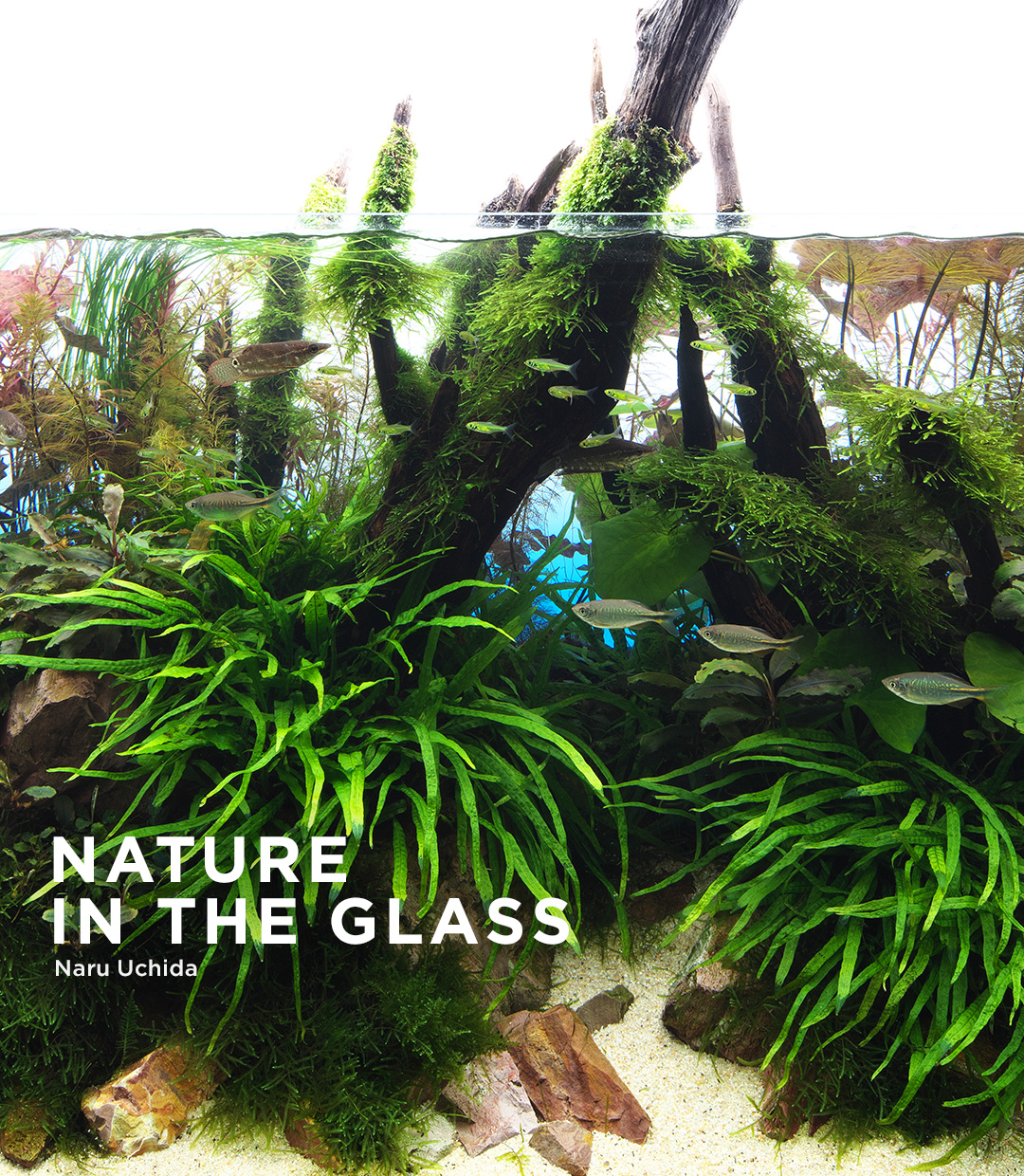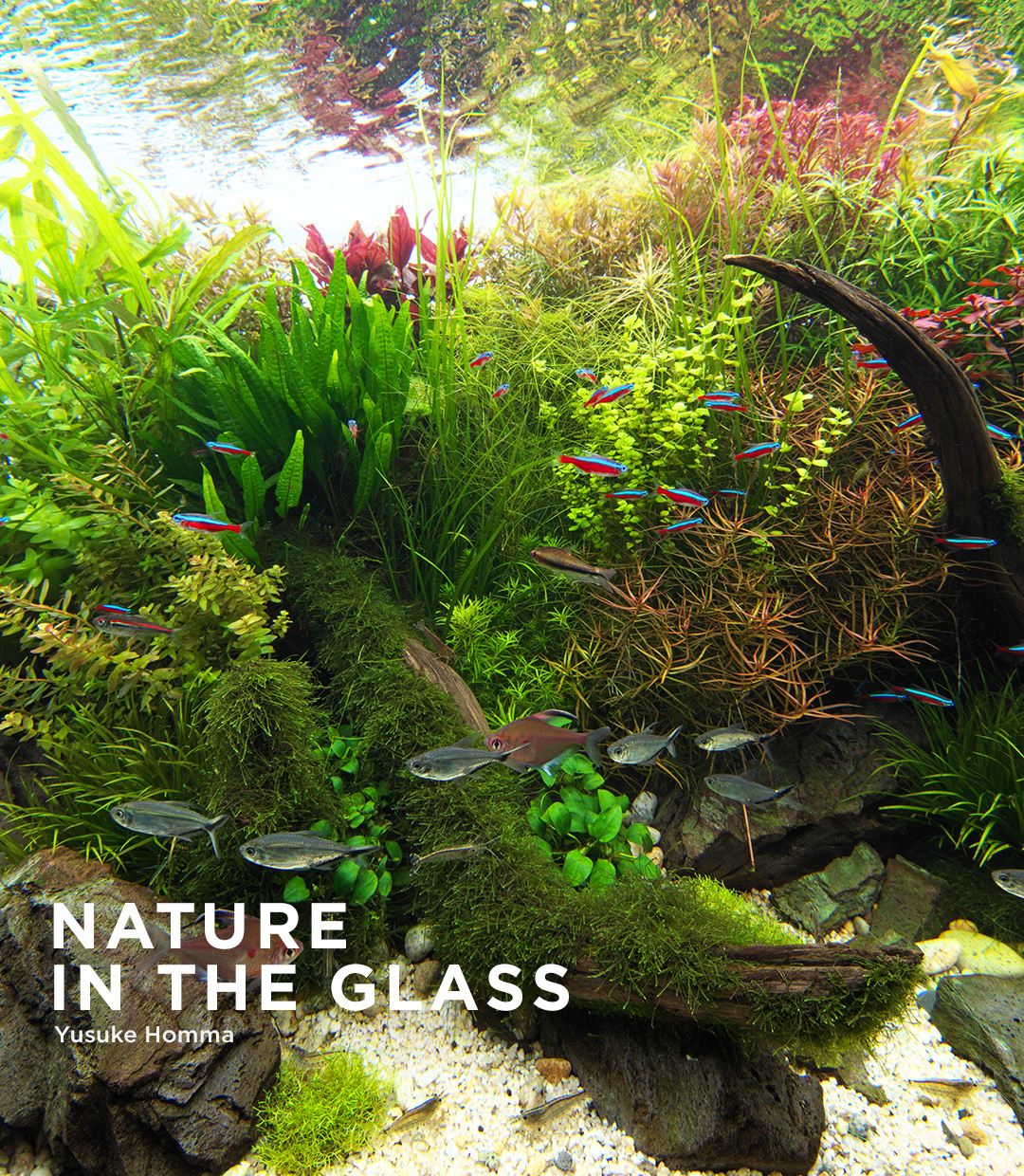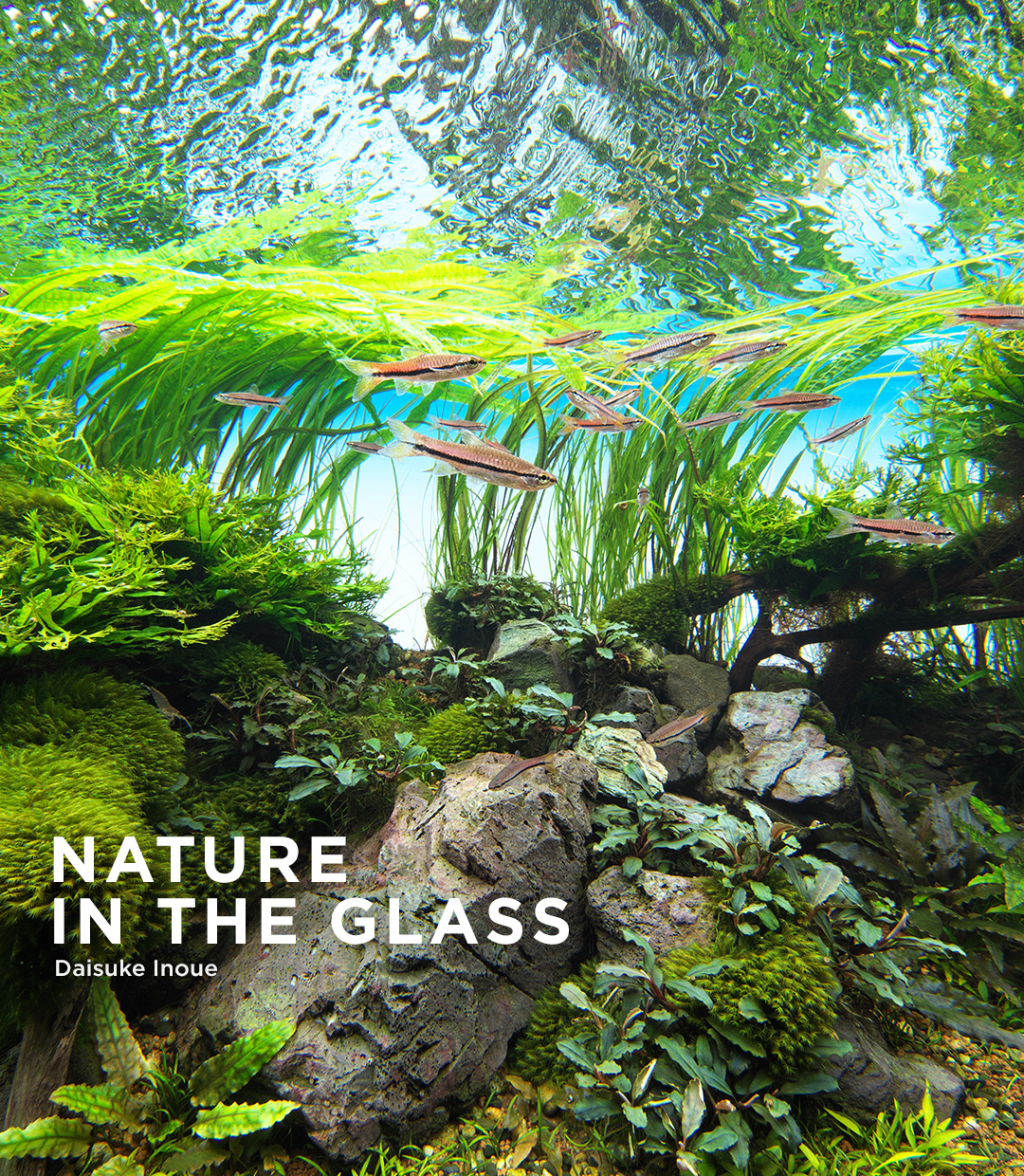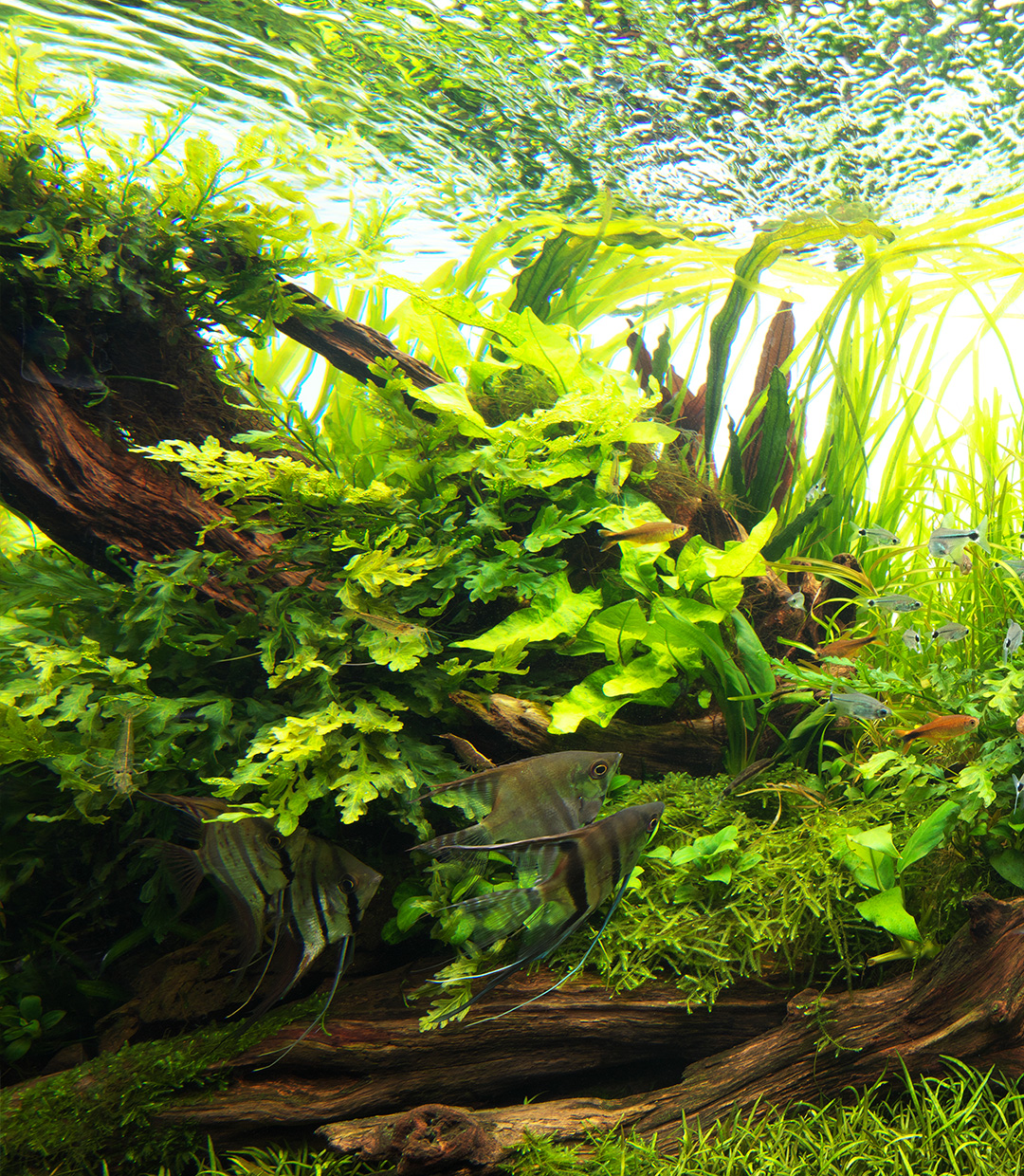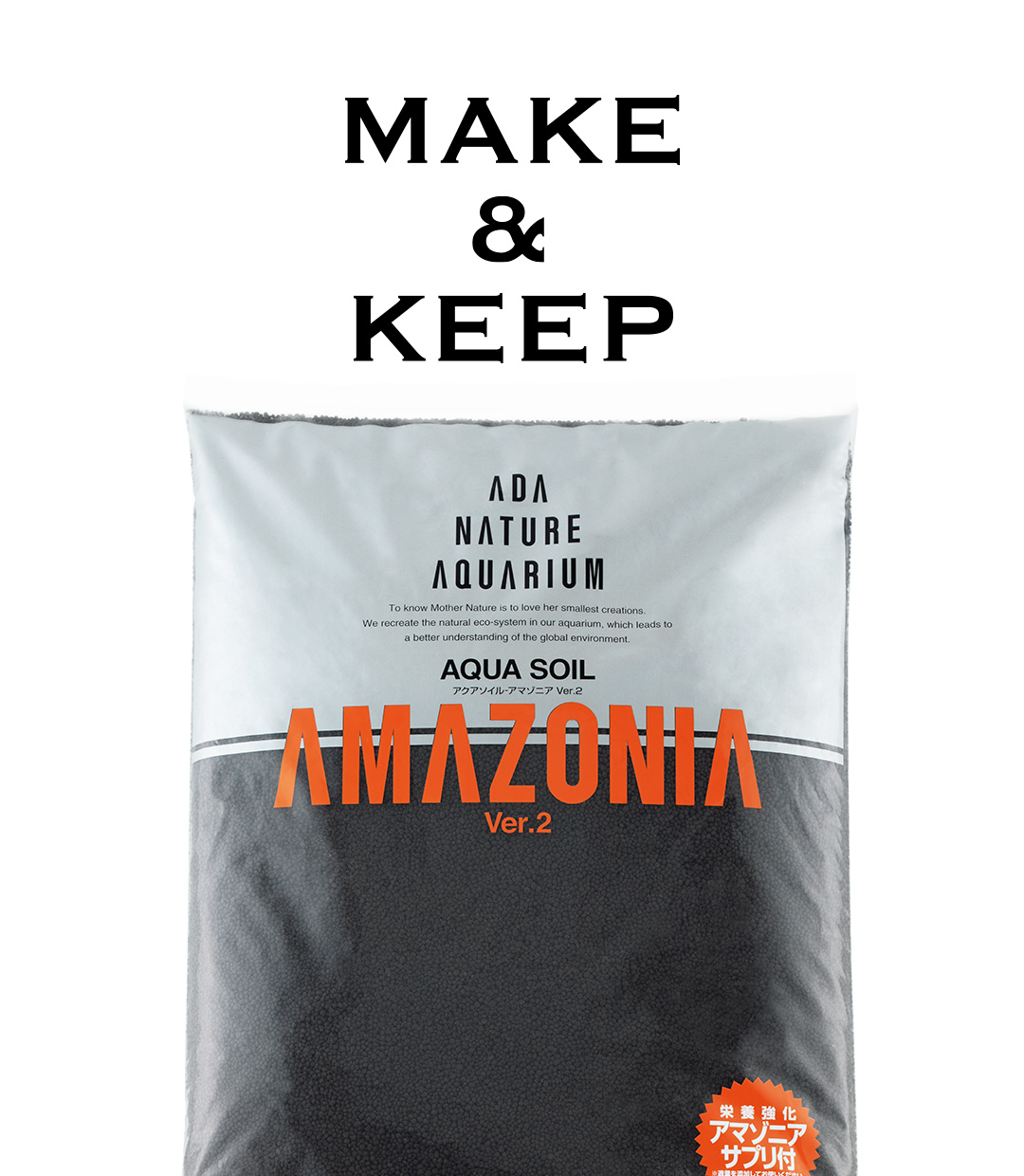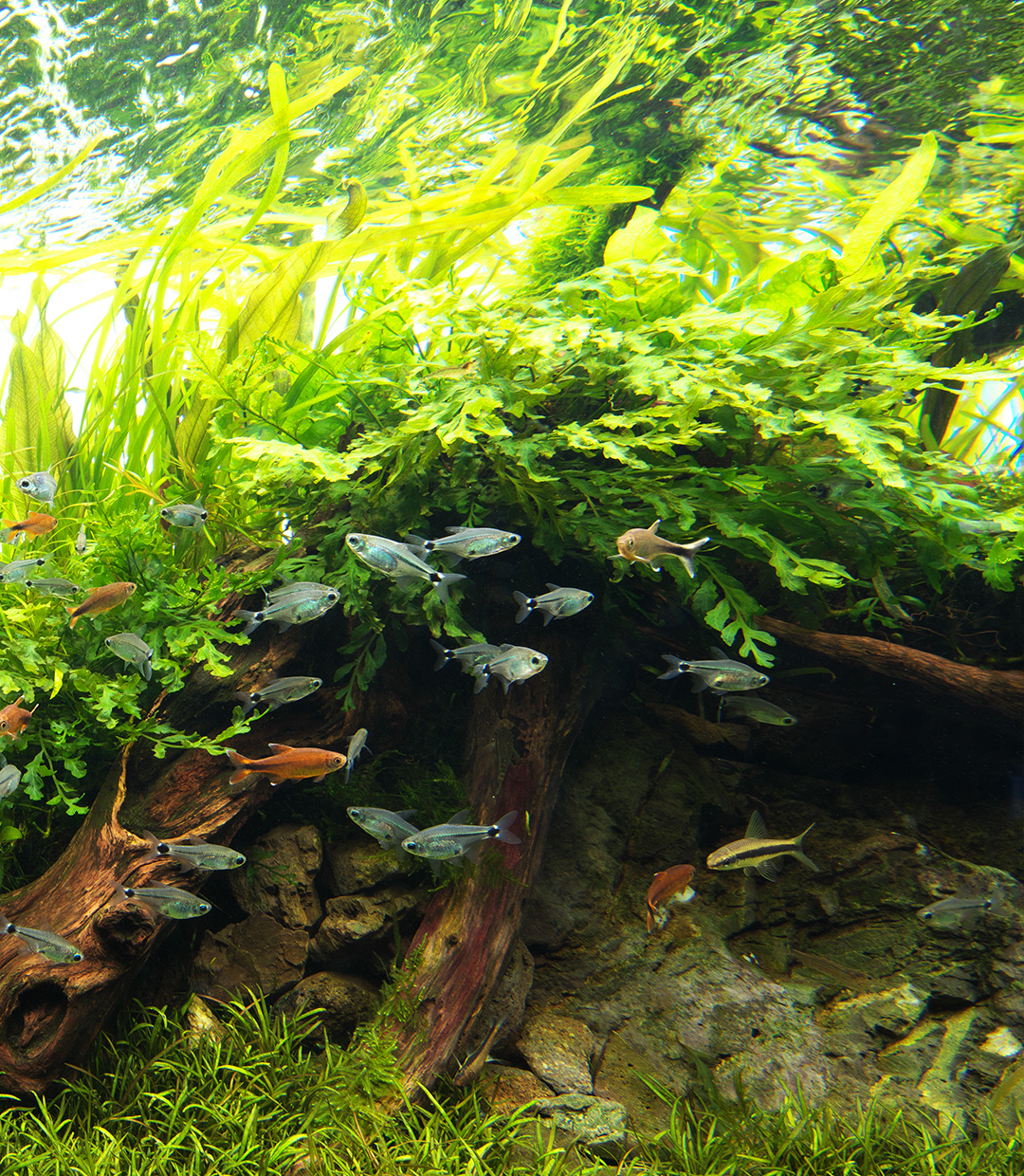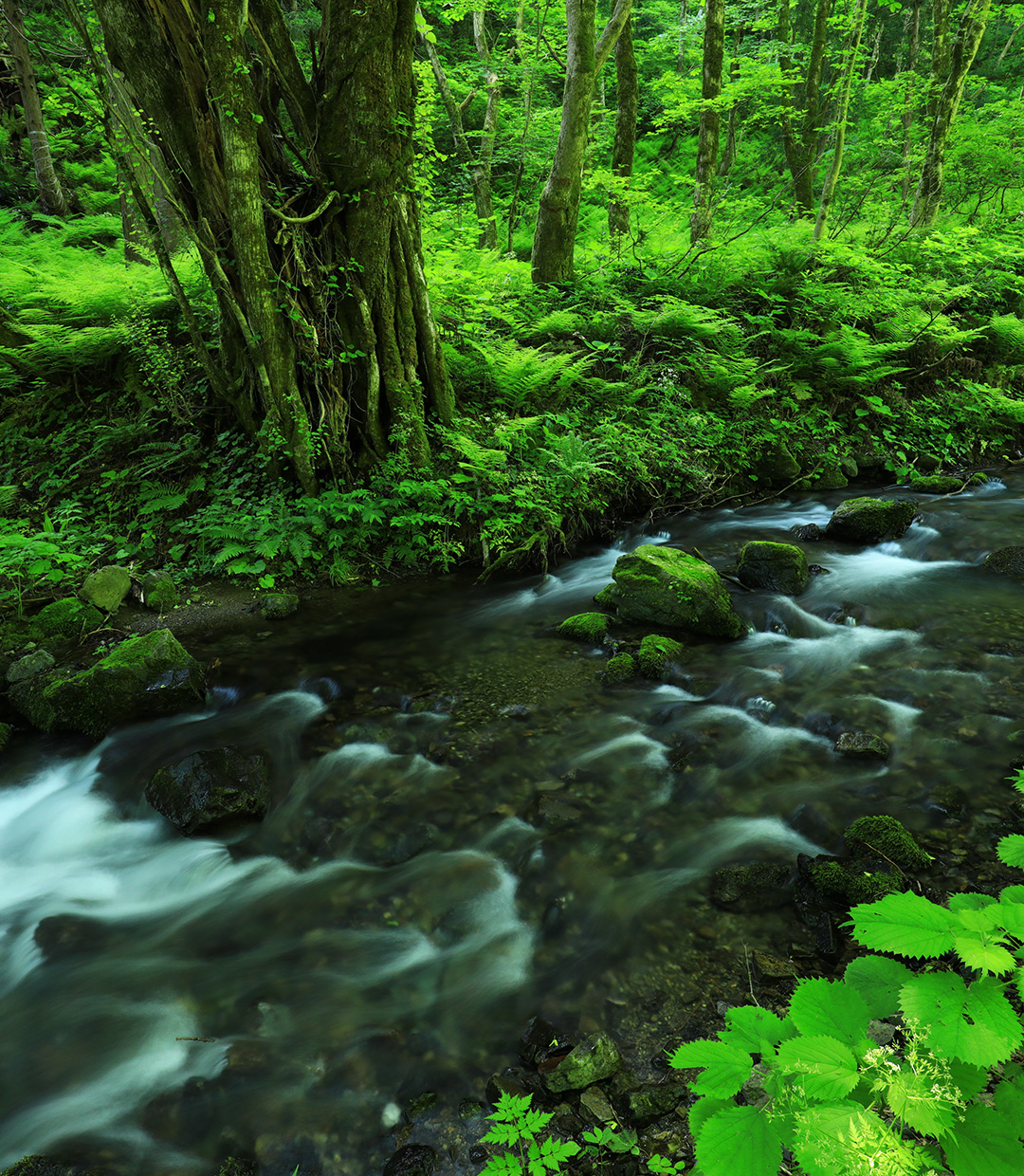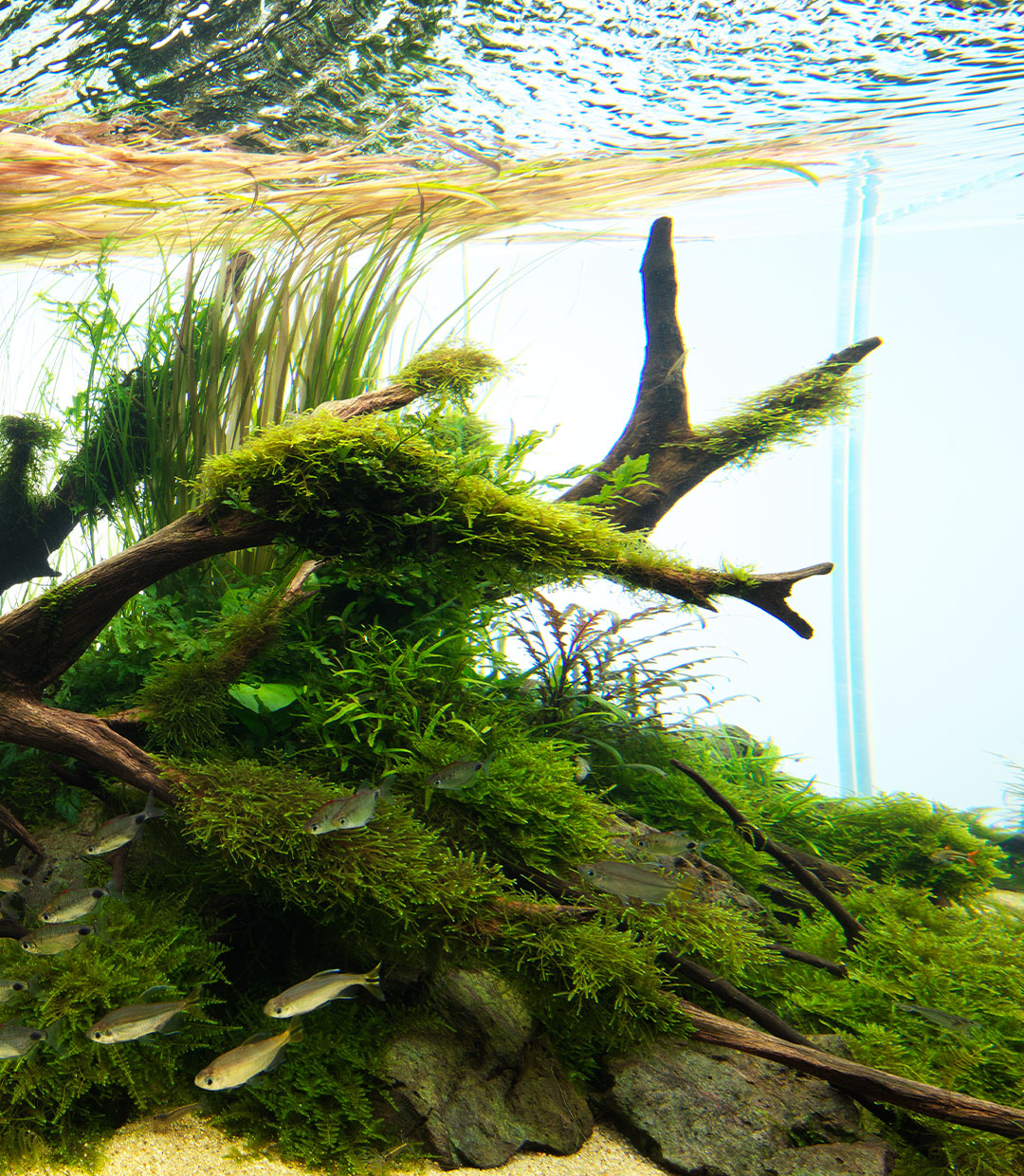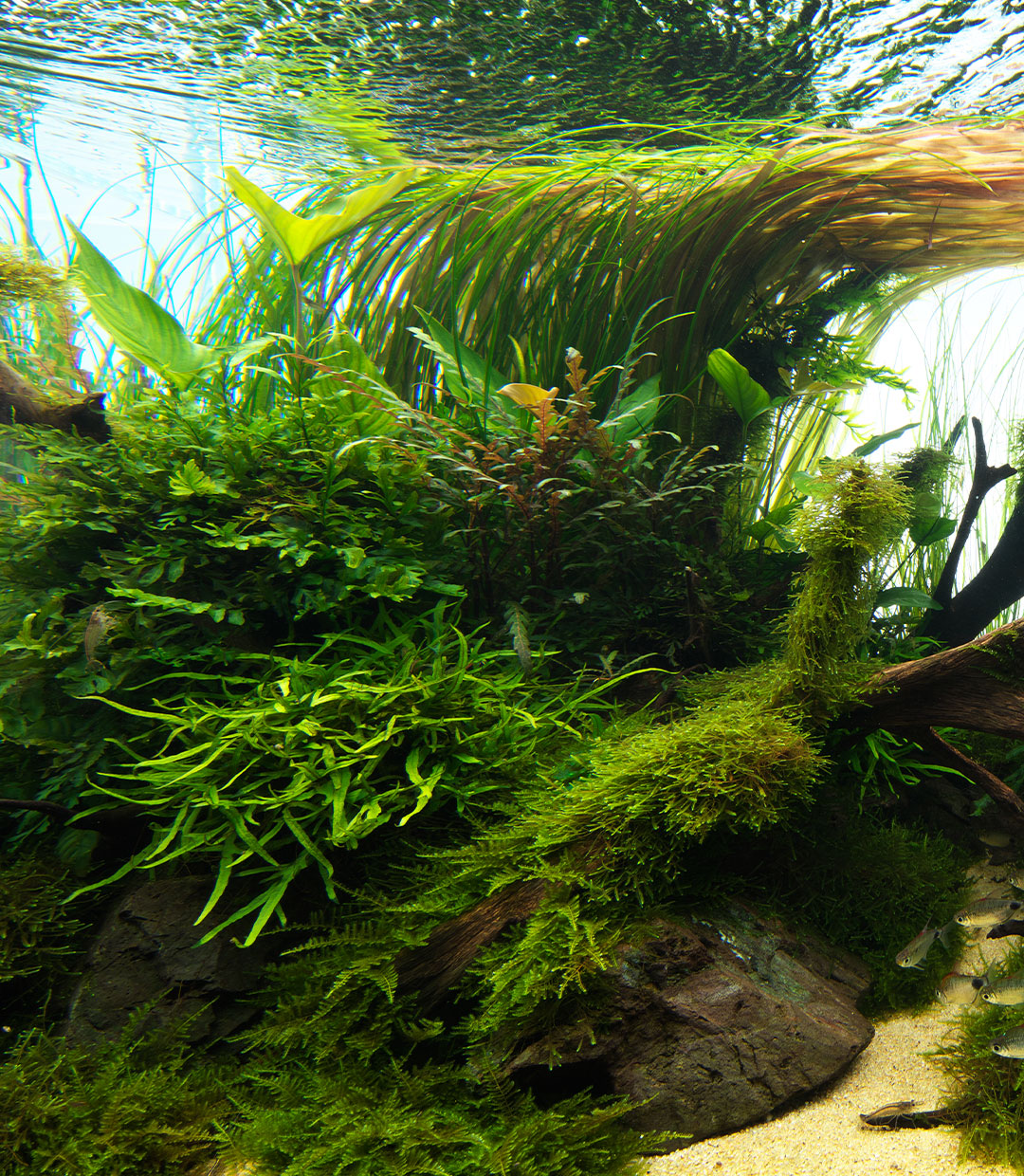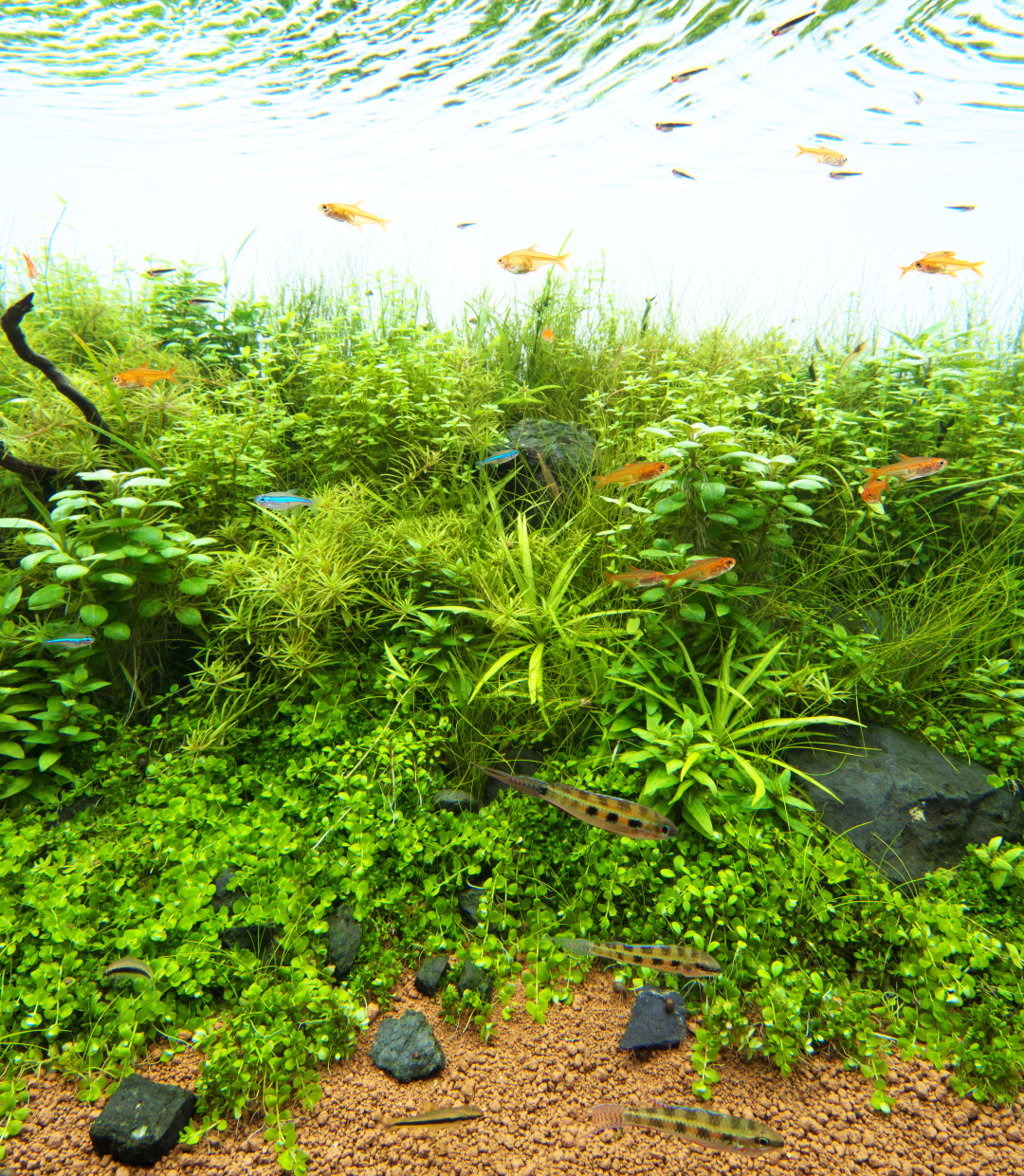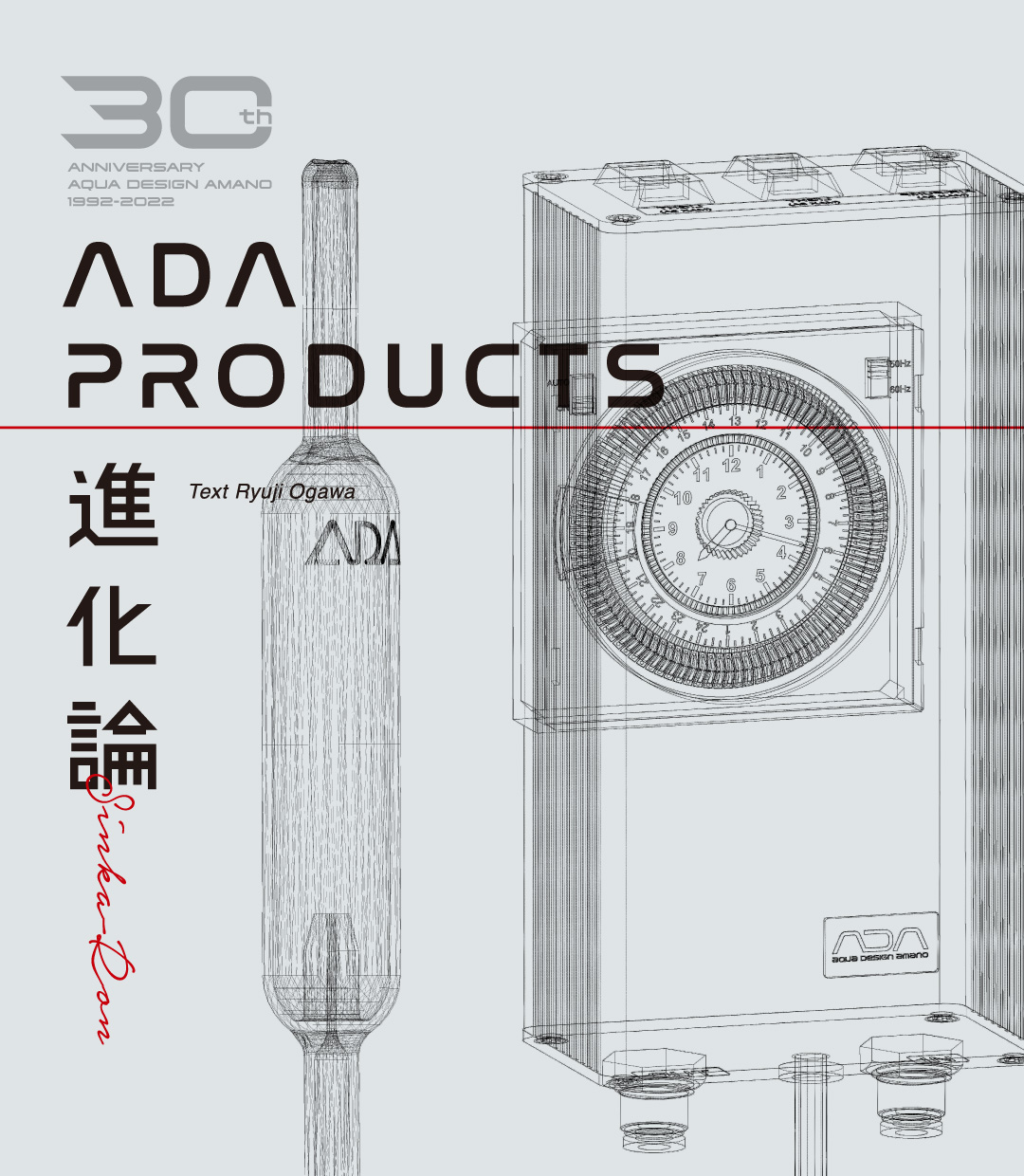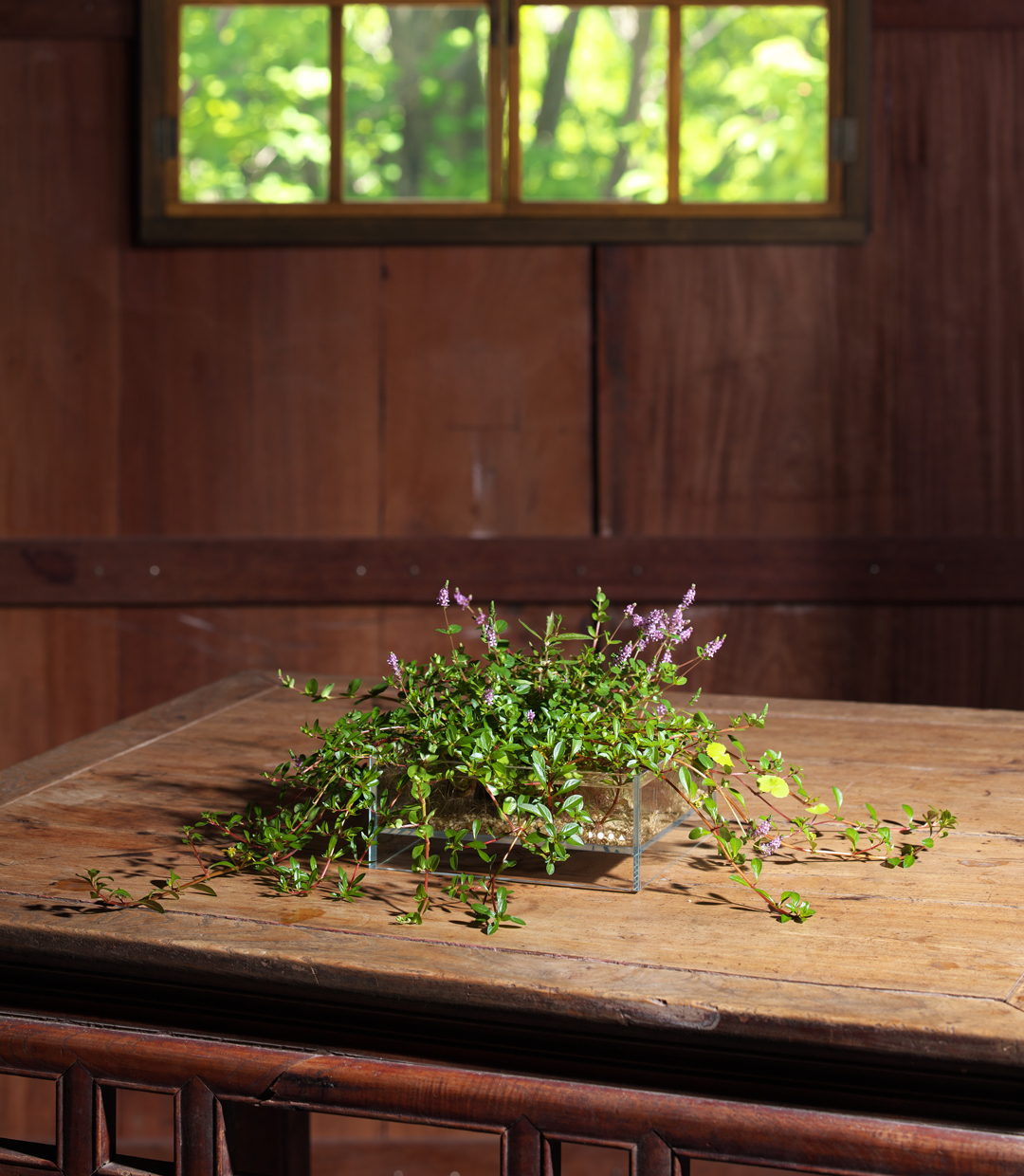NATURE IN THE GLASS ‘Forest of Harshness and Generosity’ Part 1
Harshness and Gentleness,
Expressing both sides of Nature,
With Sciophytic Aquatic Plants and Echinodorus
Trees living in harsh nature such as Yakushima Island tolerate environmental changes such as rain and wind by creating strong and solid bases while rooting not only in soil but also on rocks. And when some trees complete their lives and become dead or fallen trees, some undergrowth plants such as mosses and ferns start growing on those dead or fallen trees, and they become nurseries for other new lives. So I expressed an aspect of plants living vigorously in such harsh nature as an aquascape. Stones and pieces of driftwood were arranged while having an image of roots of trees eating into rocks for the composition, and some sciophytic aquatic plants such as mosses and ferns were attached there. Various Echinodorus planted in the back are from South America where Pterophyllum scalare and Serrapinnus kriegi in this aquascape are also from. The Echinodorus gives generous gentleness even in severity to this aquascape.
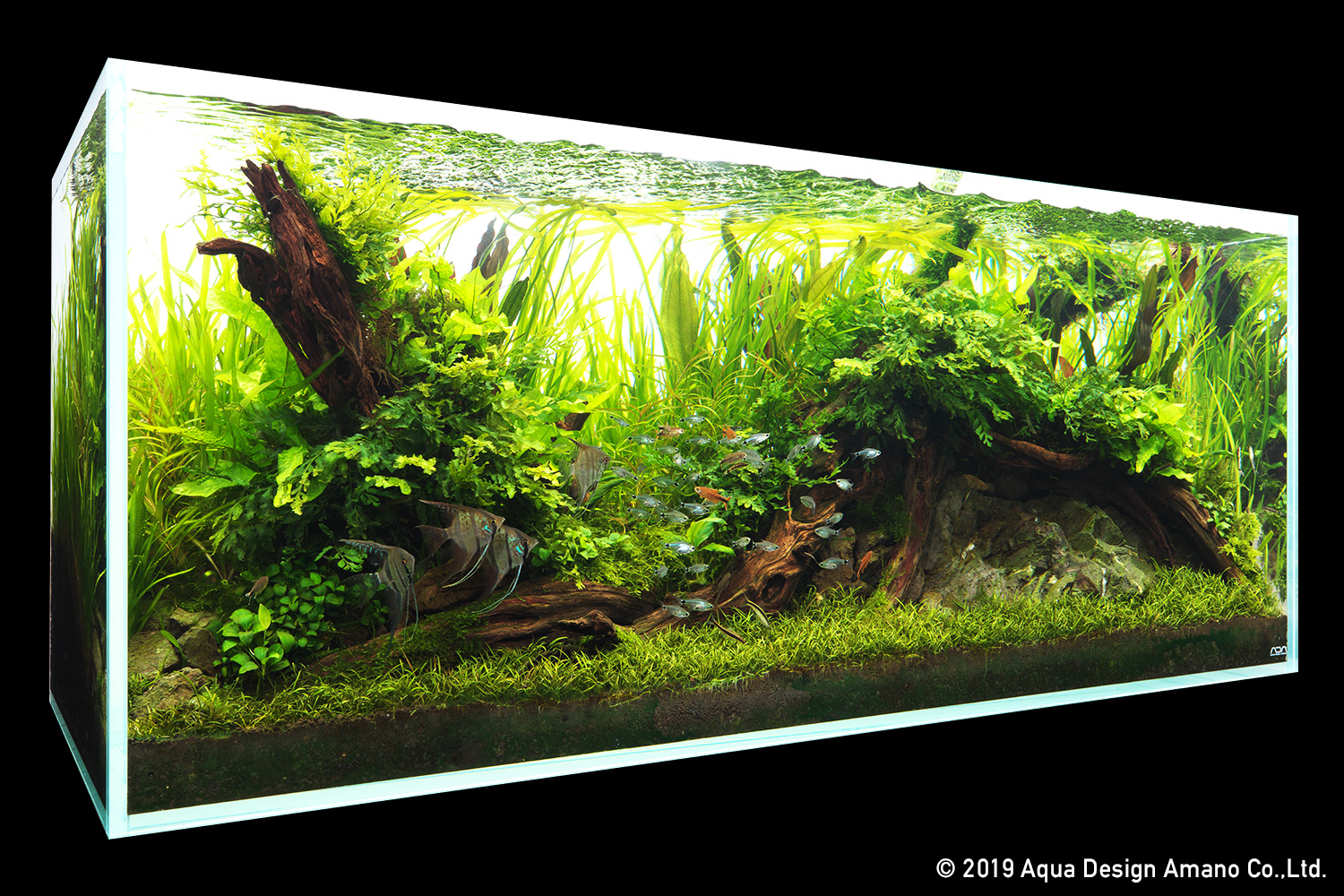
DATA
Shooting date: September 11th, 2019(ADA)
Creator: Naru Uchida
Aquarium: Cube Garden W120×D50×H50(cm)
Lighting: Solar RGB x 2, turned on for 8.5 hours per day
Filter: Super Jet Filter ES-1200(Bio Rio L)
Material: Horn Wood, Manten Stone
Substrate: Aqua Soil – Amazonia II, Power Sand Advance L, Bacter100, Clear Super, Tourmaline BC
CO2: Pollen Glass Beetle 40Ø, 5 bubbles per second via CO2 Beetle Counter (using Tower)
Aeration: 15.5 hours after the light is turned off using Lily Pipe P-6
Additives: Brighty K, Green Brighty Mineral, Green Brighty Iron, Green Brighty Nitrogen, Phyton Git (After water change)
Water change: 1/3 once a week
Water quality: Temperature: 25ºC; pH: 6.4; TH: 20 mg/l
Plant
Bio Mizukusa No Mori Anubias barteri var. nana ‘Petite’
Bio Mizukusa No Mori Lilaeopsis novae-zelandiae
Bolbitis heudelotii
Anubias barteri var. glabra
Echinodorus ‘Rubin Narrow Leaf’
Echinodorus uruguayensis
Echinodorus ‘Junglester NO.1’
Vallisneria spiralis
Aponogeton ulvaceus
Potamogeton gayi
Microsorum sp. ‘Krabi’
Taxiphyllum barbieri (Moss Bag)
Fish
Hasemania nana
Serrapinnus kriegi
Pterophyllum scalare
Crossocheilus oblongus
Otocinclus sp.
Caridina multidentata
Upon creating the layout this time, I wanted to incorporate images of beautiful scenery I have encountered so far in my life. But because an impression of an aquascape might look too tight if cramming all the elements in the aquascape, I decided to incorporate only the essence of nature and created the layout focusing on the overall balance. This time, a main motif I chose was the Sukkan-Sawa stream in Tochigi Prefecture where I visited last summer. Although it is said that to learn from nature is very important in Nature Aquarium, I think it will be more helpful to experience nature with a purpose of photo shooting for creating a layout instead of just visiting nature. In the teaching of Takashi Amano, cutting out a piece of nature with a camera becomes a great training in order to create a composition in an aquarium tank.
Shooting date: September 11th, 2019(ADA)
Creator: Naru Uchida
Aquarium: Cube Garden W120×D50×H50(cm)
Lighting: Solar RGB x 2, turned on for 8.5 hours per day
Filter: Super Jet Filter ES-1200(Bio Rio L)
Material: Horn Wood, Manten Stone
Substrate: Aqua Soil – Amazonia II, Power Sand Advance L, Bacter100, Clear Super, Tourmaline BC
CO2: Pollen Glass Beetle 40Ø, 5 bubbles per second via CO2 Beetle Counter (using Tower)
Aeration: 15.5 hours after the light is turned off using Lily Pipe P-6
Additives: Brighty K, Green Brighty Mineral, Green Brighty Iron, Green Brighty Nitrogen, Phyton Git (After water change)
Water change: 1/3 once a week
Water quality: Temperature: 25ºC; pH: 6.4; TH: 20 mg/l
Plant
Bio Mizukusa No Mori Anubias barteri var. nana ‘Petite’
Bio Mizukusa No Mori Lilaeopsis novae-zelandiae
Bolbitis heudelotii
Anubias barteri var. glabra
Echinodorus ‘Rubin Narrow Leaf’
Echinodorus uruguayensis
Echinodorus ‘Junglester NO.1’
Vallisneria spiralis
Aponogeton ulvaceus
Potamogeton gayi
Microsorum sp. ‘Krabi’
Taxiphyllum barbieri (Moss Bag)
Fish
Hasemania nana
Serrapinnus kriegi
Pterophyllum scalare
Crossocheilus oblongus
Otocinclus sp.
Caridina multidentata
Expressing in an aquascape incorporating the essence of nature
Upon creating the layout this time, I wanted to incorporate images of beautiful scenery I have encountered so far in my life. But because an impression of an aquascape might look too tight if cramming all the elements in the aquascape, I decided to incorporate only the essence of nature and created the layout focusing on the overall balance. This time, a main motif I chose was the Sukkan-Sawa stream in Tochigi Prefecture where I visited last summer. Although it is said that to learn from nature is very important in Nature Aquarium, I think it will be more helpful to experience nature with a purpose of photo shooting for creating a layout instead of just visiting nature. In the teaching of Takashi Amano, cutting out a piece of nature with a camera becomes a great training in order to create a composition in an aquarium tank.
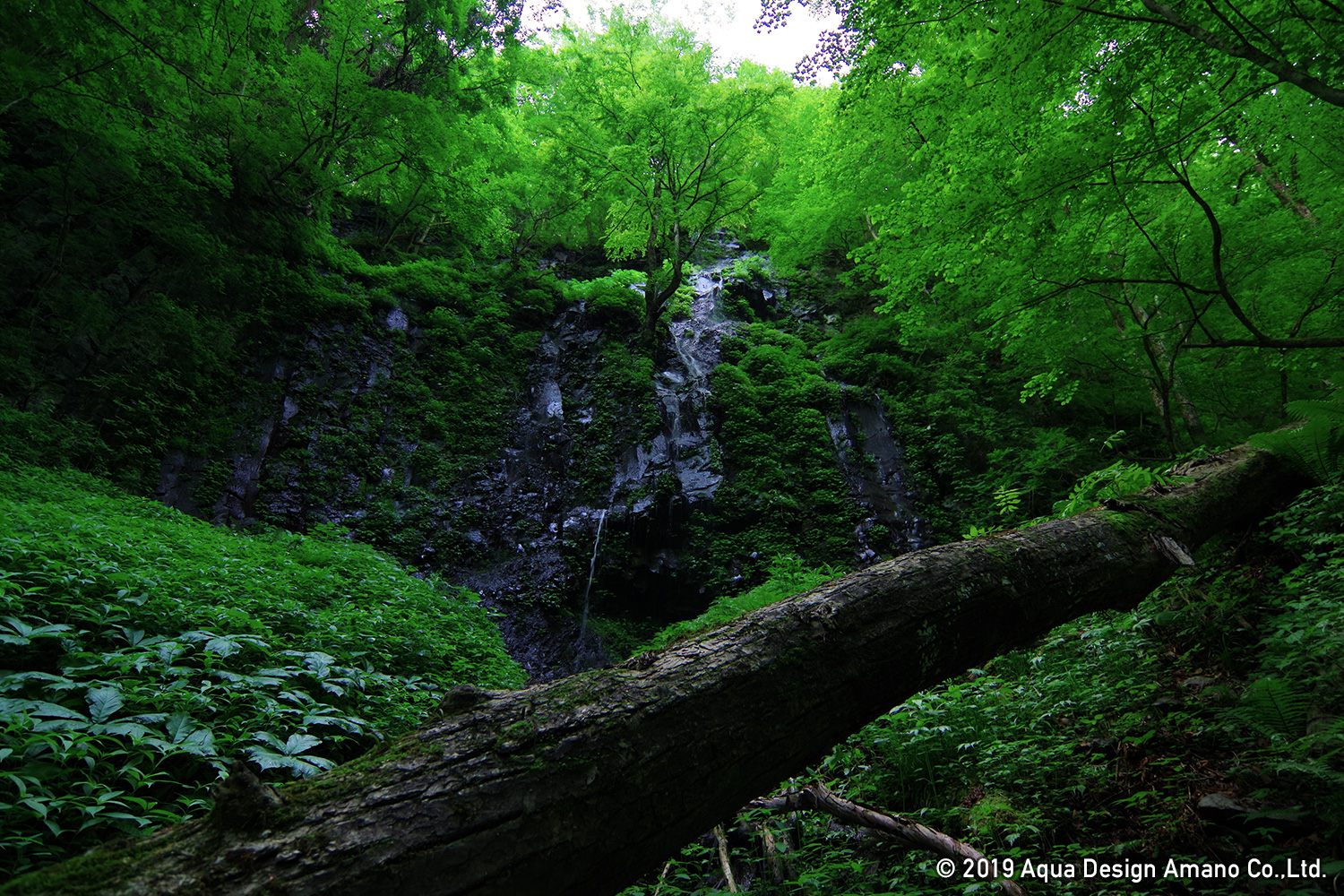
Inspiration from scenery 1
This time, a motif I chose for the composition is a fallen tree that I encountered in the Sukkan-Sawa stream in Tochigi Prefecture I visited last summer. Although it seems that the tree fell down due to exposure to rain and wind for a long period of time, I was so impressed by the dignified appearance of the fallen tree even after ending of its life. So I decided to choose it as a theme for the layout.
Sukkan-Sawa stream, Nasu-Shiobara City, Tochigi Prefecture Early June, 2018 / Shooting Naru Uchida
This time, a motif I chose for the composition is a fallen tree that I encountered in the Sukkan-Sawa stream in Tochigi Prefecture I visited last summer. Although it seems that the tree fell down due to exposure to rain and wind for a long period of time, I was so impressed by the dignified appearance of the fallen tree even after ending of its life. So I decided to choose it as a theme for the layout.
Sukkan-Sawa stream, Nasu-Shiobara City, Tochigi Prefecture Early June, 2018 / Shooting Naru Uchida
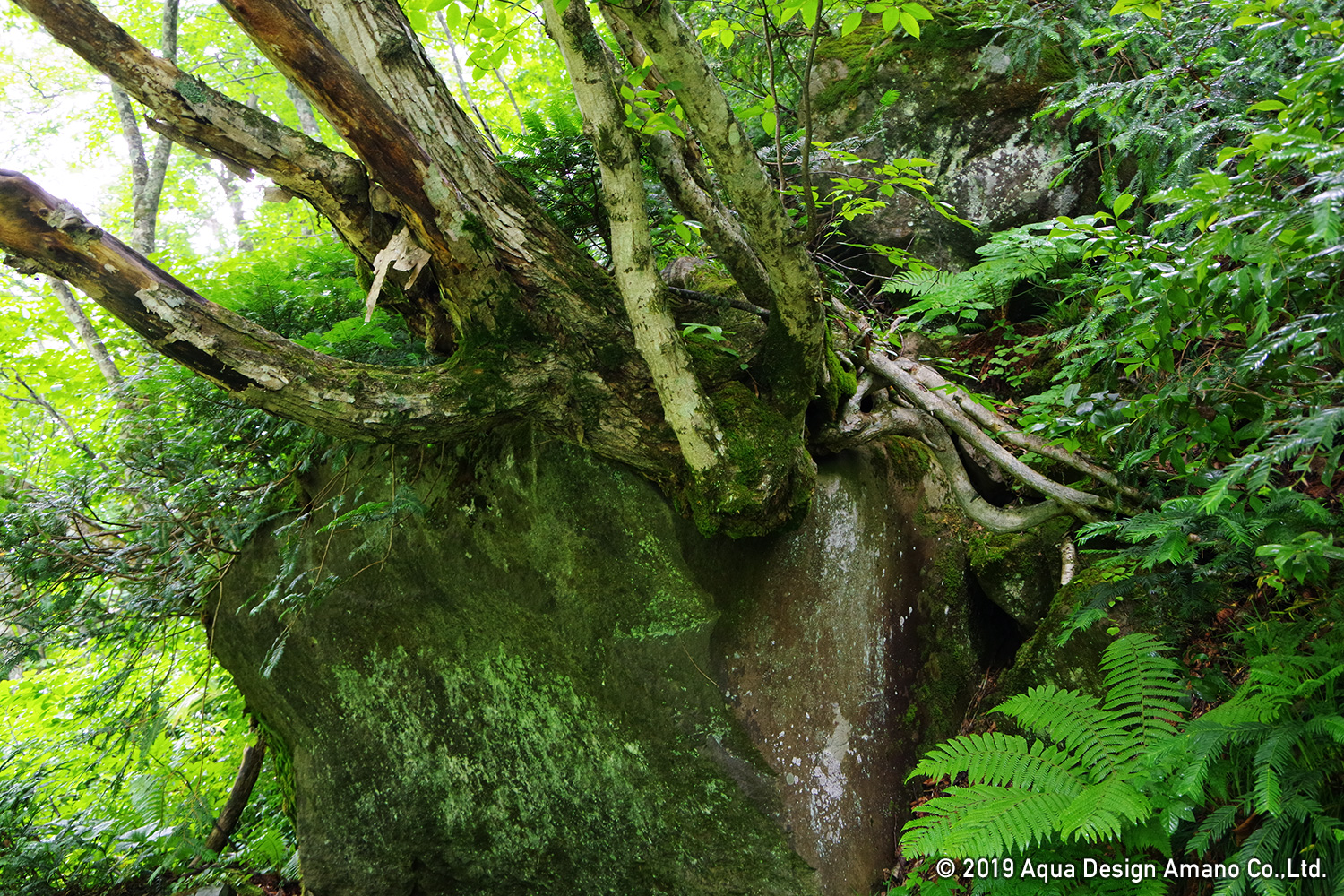
Inspiration from scenery 2
A large stone on the right side was placed while imaging a massive stone been vigorously rooted by a tree. Because I wanted to create a hideout for fish in the stone part, some ferns were planted for it.
A large stone on the right side was placed while imaging a massive stone been vigorously rooted by a tree. Because I wanted to create a hideout for fish in the stone part, some ferns were planted for it.
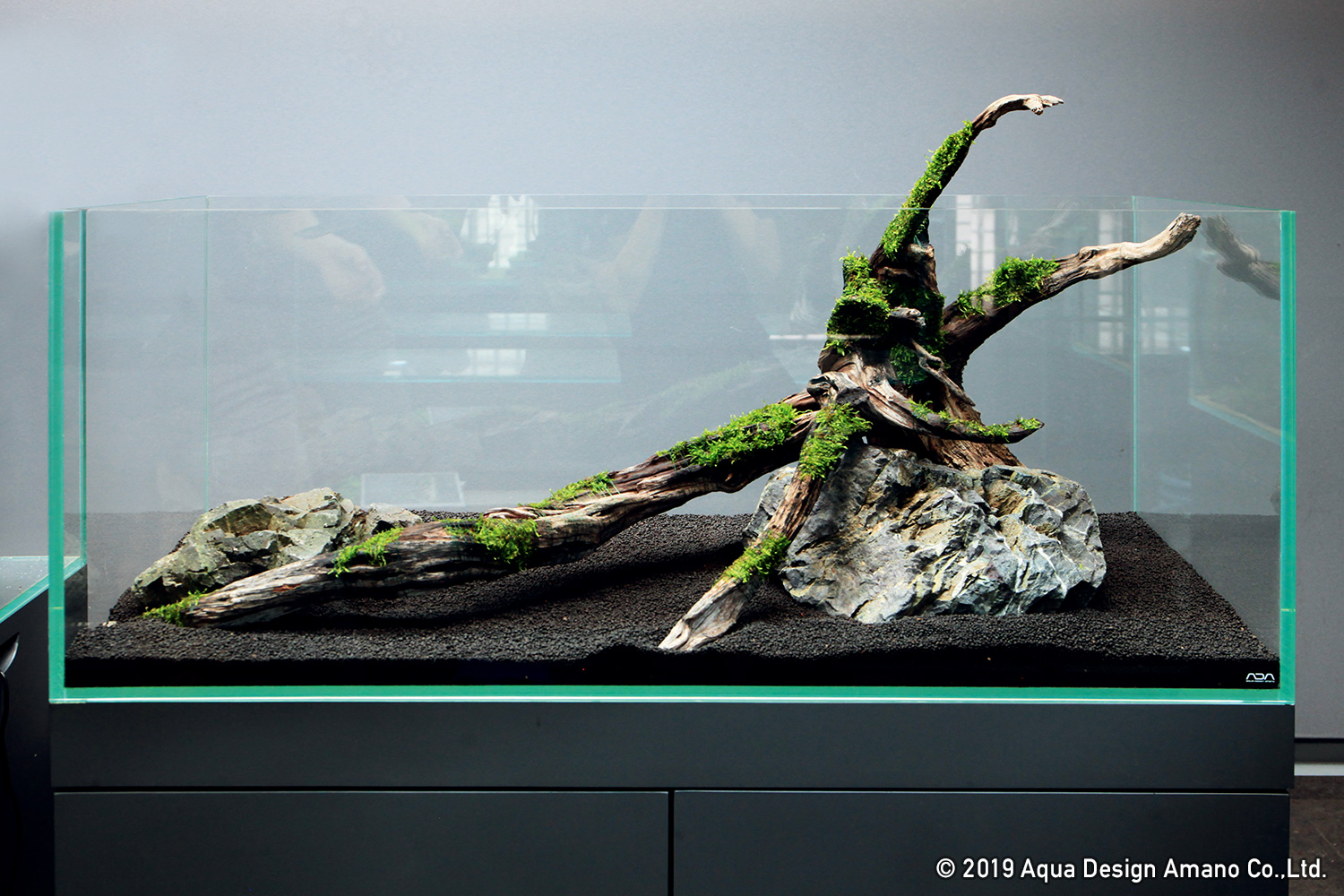
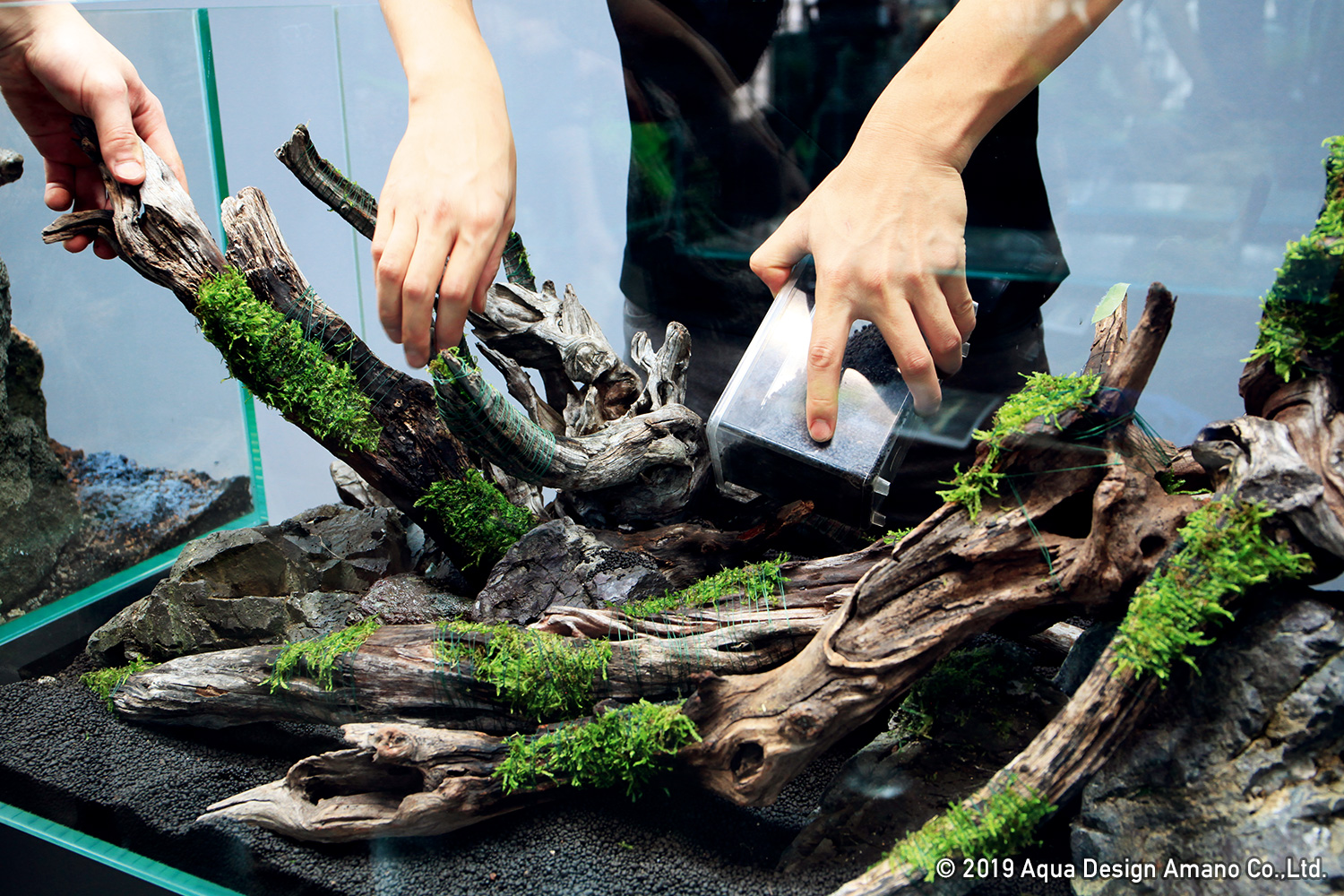
Key points for creating a composition
When creating a composition, key points are to roughly arrange materials that are close to one’s own image first and to decide on a balance of a main material to the space. I fixed the composition by pouring some pebbles and soil into gaps between the materials for the long term maintenance purpose.
When creating a composition, key points are to roughly arrange materials that are close to one’s own image first and to decide on a balance of a main material to the space. I fixed the composition by pouring some pebbles and soil into gaps between the materials for the long term maintenance purpose.
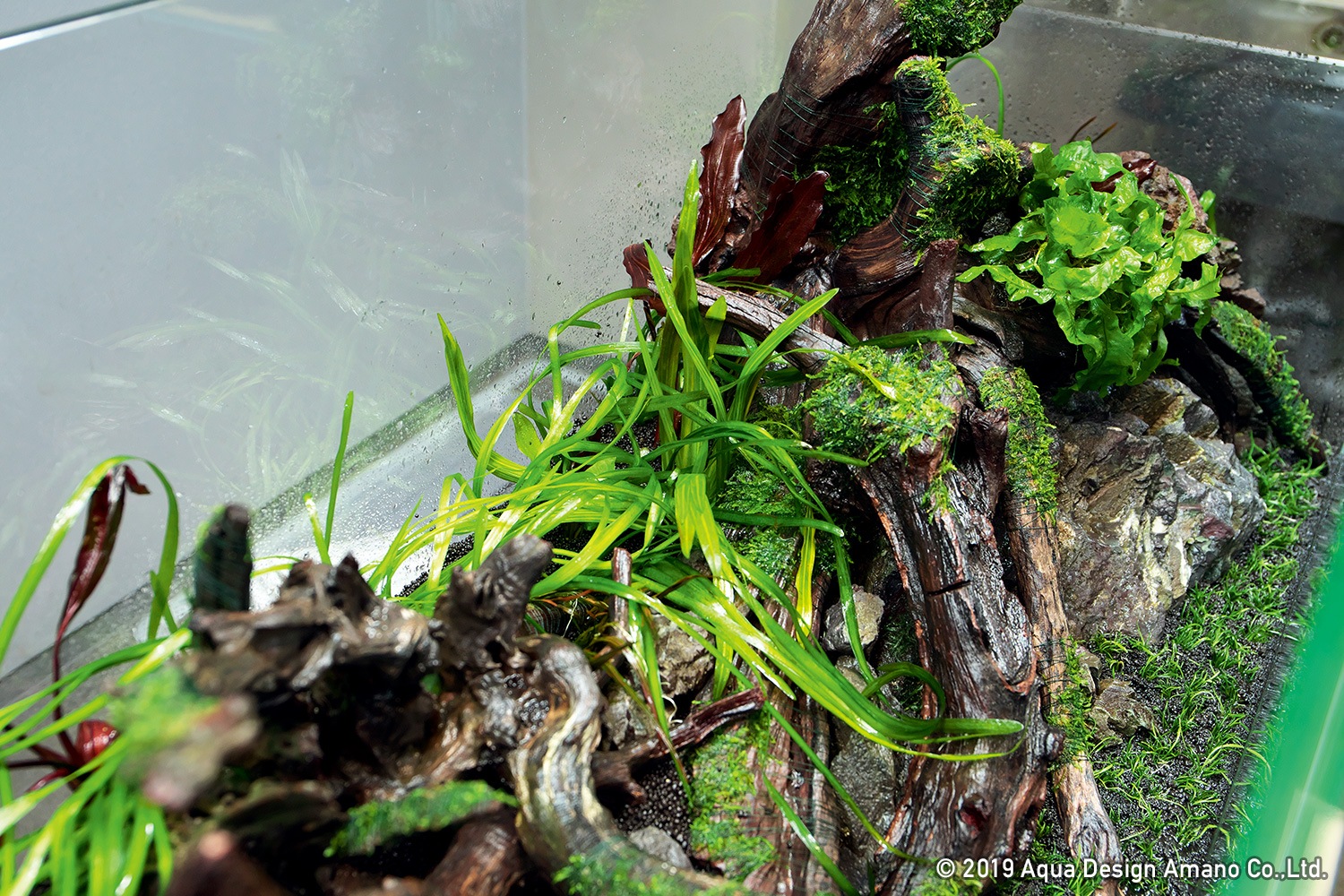
Planting in the back
Tape shaped Echinodorus uruguayensis and Vallisneria spiralis were planted in the back.
Because Vallisneria tends to grow faster, they were purposely planted modestly not to cast a shadow on the Echinodorus.
Tape shaped Echinodorus uruguayensis and Vallisneria spiralis were planted in the back.
Because Vallisneria tends to grow faster, they were purposely planted modestly not to cast a shadow on the Echinodorus.
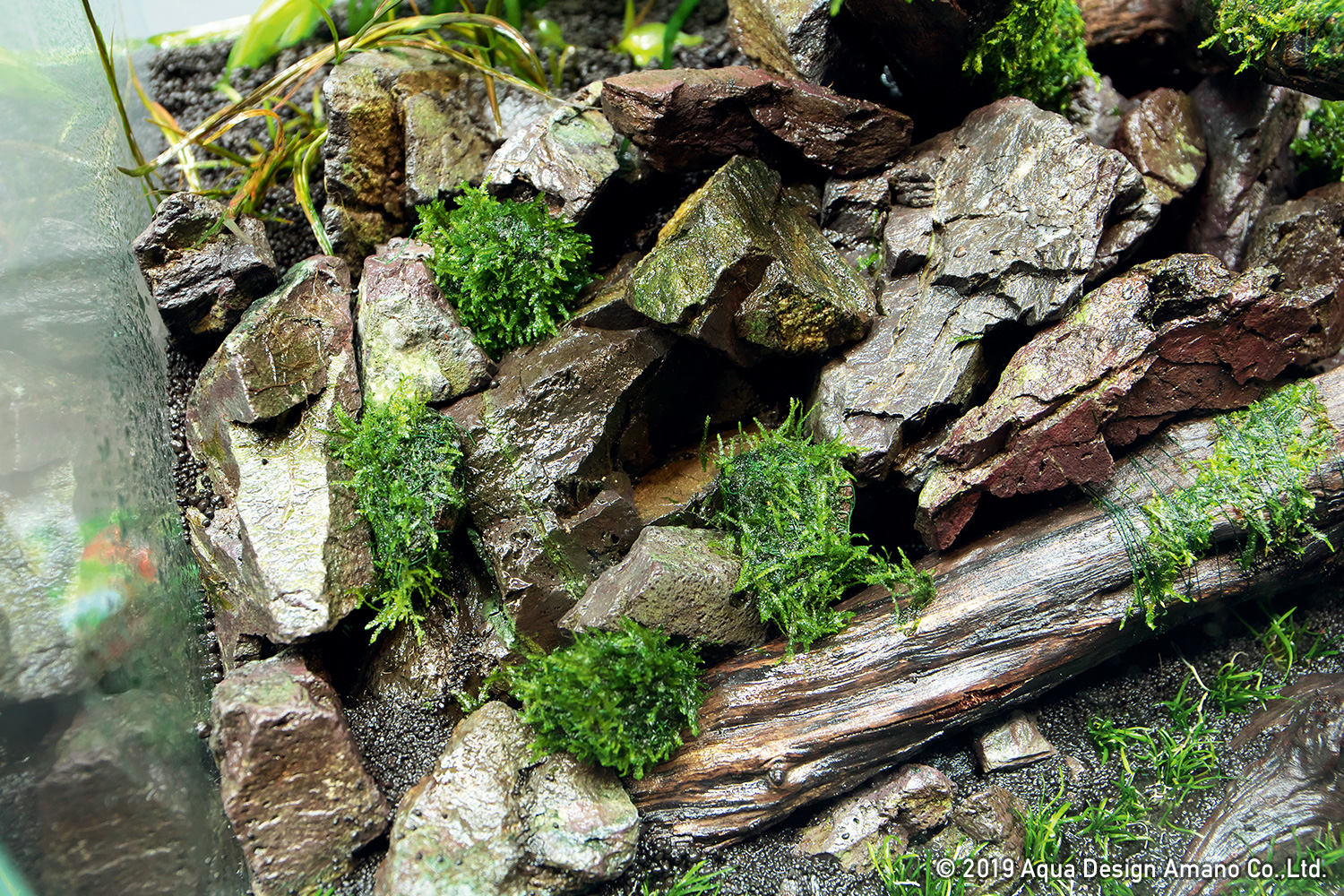
Expressing a scree
By placing some small stones with moss attached in a scree where slightly smaller stones were stacked, mossy nature is expressed with time.
By placing some small stones with moss attached in a scree where slightly smaller stones were stacked, mossy nature is expressed with time.
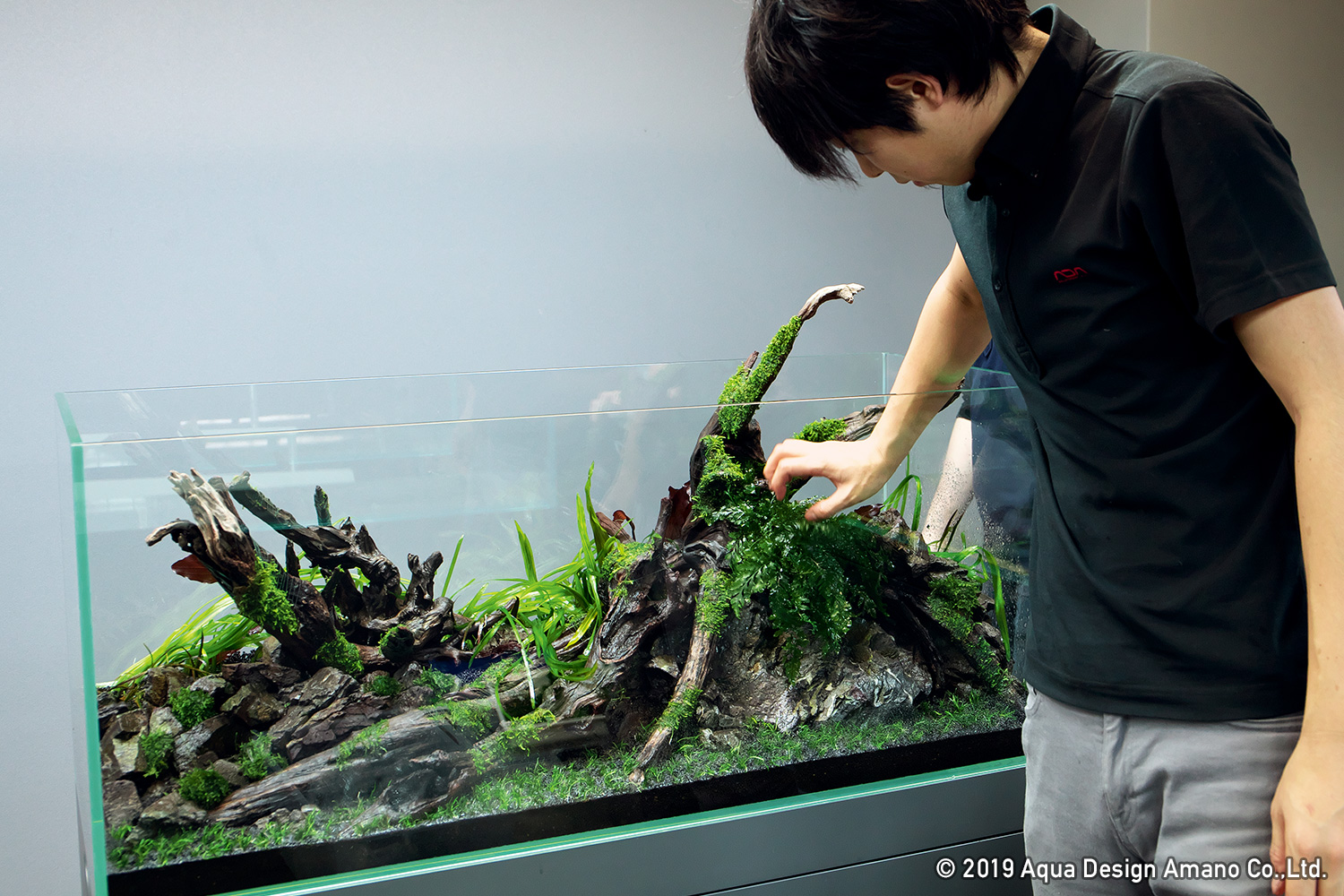
A key point for planting ferns
A key point for planting of ferns is to plant them while carefully looking at the overall balance. It is better to combine some Bolbitis and Microsorum because together they create rhythm with the shades of dark and light greens instead of using single type of fern, and by doing so, the monotonousness fades.
A key point for planting of ferns is to plant them while carefully looking at the overall balance. It is better to combine some Bolbitis and Microsorum because together they create rhythm with the shades of dark and light greens instead of using single type of fern, and by doing so, the monotonousness fades.
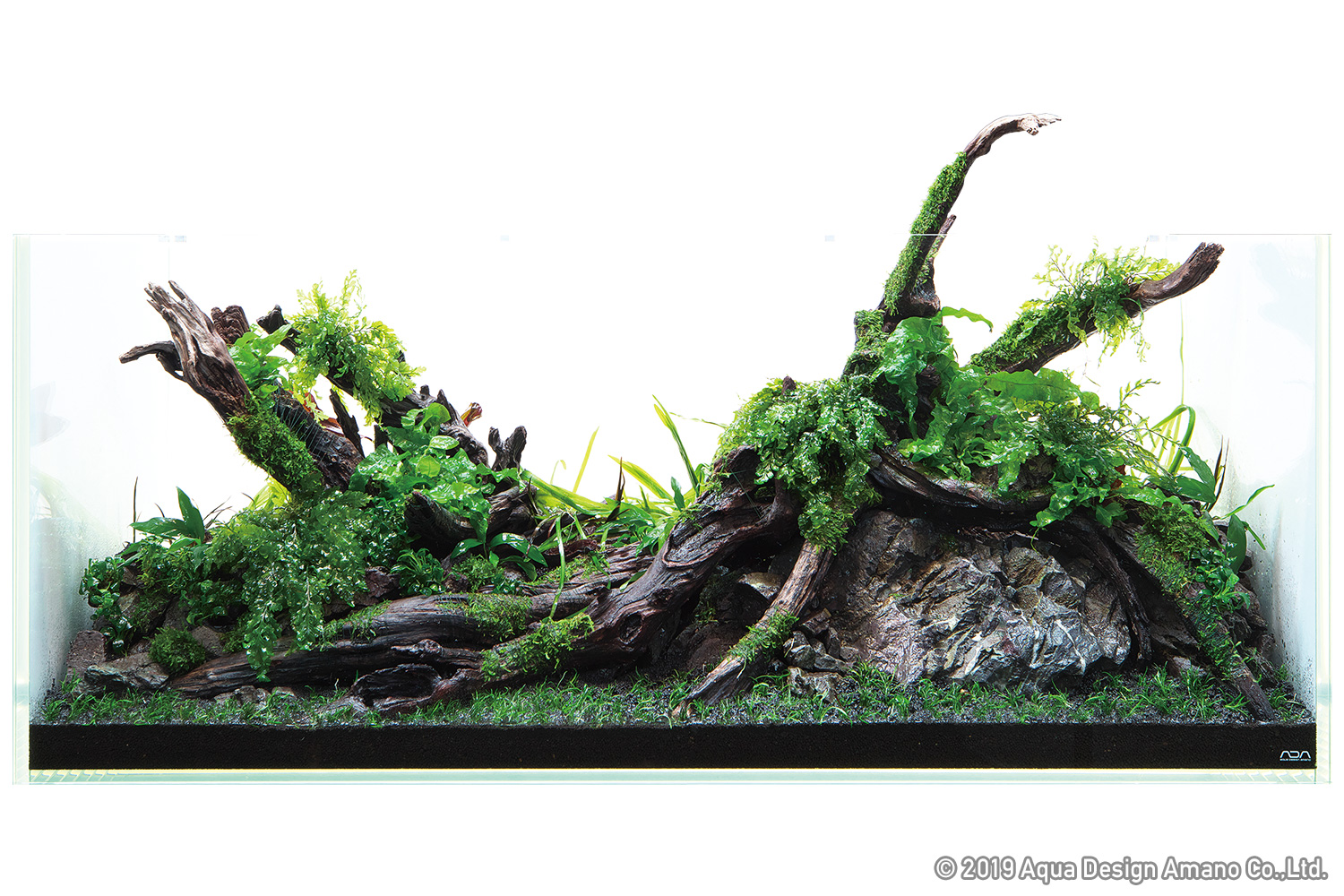
The layout right after planting
In a layout with many ferns and mosses, an impression of some materials often tends to fade due to growth of the plants as time progresses. For that reason, clearly creating exposed parts of stones and driftwood will likely give sharpness to a completed aquascape.
Shooting on February 15th, 2019
In a layout with many ferns and mosses, an impression of some materials often tends to fade due to growth of the plants as time progresses. For that reason, clearly creating exposed parts of stones and driftwood will likely give sharpness to a completed aquascape.
Shooting on February 15th, 2019
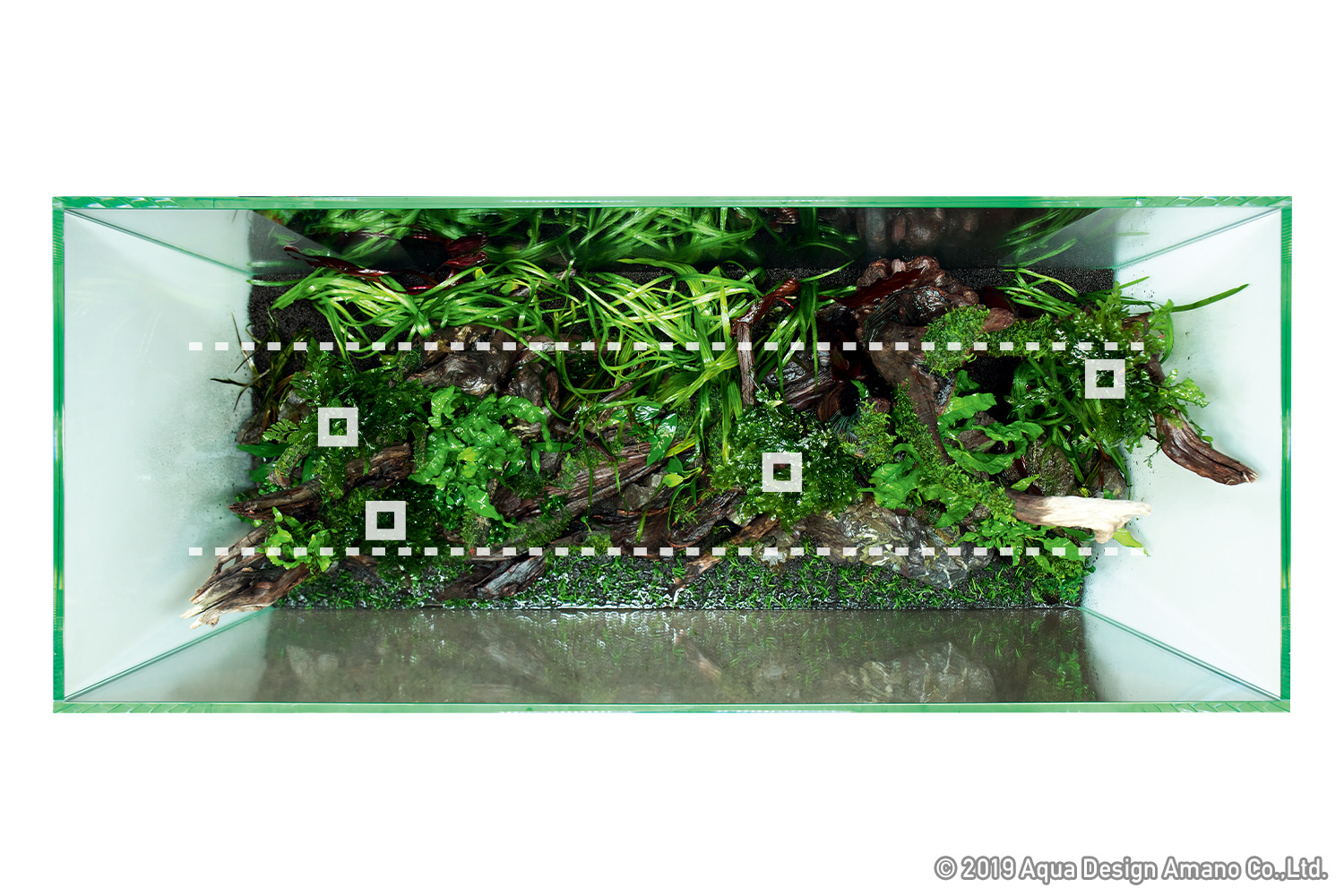
An aspect right after planting looking from above
A key point for planting ferns is to prevent its leaves and aquatic plants planted in the front and back from overlapping with each other when looking at the aquarium tank form the above. By doing so, sufficient light of lighting equipments will reach to the whole aquarium tank, and therefore all the aquatic plants will grow well.
A key point for planting ferns is to prevent its leaves and aquatic plants planted in the front and back from overlapping with each other when looking at the aquarium tank form the above. By doing so, sufficient light of lighting equipments will reach to the whole aquarium tank, and therefore all the aquatic plants will grow well.
![[ STYLE OF EPIPHYTIC PLANTS ] Effective use of epiphytic aquatic plants in layout scenes](https://www.adana.co.jp/wp-content/uploads/sites/3/2024/04/ep_img_ogp.jpg)
